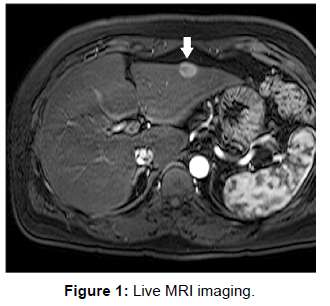Quantitative Assessment of Liver capability Inside MR Imaging
Received: 03-Aug-2022 / Manuscript No. roa-22-73702 / Editor assigned: 05-Aug-2022 / PreQC No. roa-22-73702 (PQ) / Reviewed: 19-Aug-2022 / QC No. roa-22-73702 / Revised: 23-Aug-2022 / Manuscript No. roa-22-73702 (R) / Published Date: 30-Aug-2022 DOI: 10.4172/2167-7964.1000396
Image Article
Quantitative assessment of liver capability is significant for observing of that function, yet additionally for preoperative evaluation of the liver reserve [1].
The Plasma Disappearance Rate of Indocyanine Green has been viewed as an important instrument for the quantitative evaluation of liver function, since it is taken out from the dissemination solely by the liver [2]. Anyway a solid strategy for the quantitative anatomically based assessment of segmental liver capability has not been laid out to date, to our knowledge (Figure 1).
The Future Remnant Liver Volume and a quantitative liver function test, for example, the ICG clearance test, have been accounted for to be huge indicators of postoperative liver failure and mortality [1,3]. Nonetheless, with volumetry, exact assessment of the segmental liver reserve could be impossible on the grounds that the heterogeneity of the liver function couldn’t be considered [4].
Gadoxetate disodium is a paramagnetic hepatobiliary contrast specialist that can combine the features of extracellular agents with those of a hepatocellular contrast agent. The equivalent shipping systems (for example the Organic Anion Transporting Polypeptides, OATPs) are viewed as liable for take-up of gadoxetate disodium and ICG in hepatocytes; therefore, there is possibility that gadoxetate disodiumimproved MR imaging could be the premise of a valuable strategy for quantitative assessment of postoperative liver disappointment like ICG clearance but with anatomic delineation of hepatic function.
References
- Seyama Y, Kokudo N (2009) Assessment of liver function for safe hepatic resection. Hepatol Res 39: 107-116.
- Sakka SG (2007) Assessing liver function. Curr Opin Crit Care 13: 207-214.
- Suda K, Ohtsuka M, Ambiru S, Kimura F, Shimizu H, et al. (2009) Risk factors of liver dysfunction after extended hepatic resection in biliary tract malignancies. Am J Surg 197: 752-758.
- Yamada A (2012) Quantitative Evaluation of Liver Function within MR Imaging. OMICS J Radiol 1: e109.
Indexed at, Google Scholar, Crossref
Indexed at, Google Scholar, Crossref
Indexed at, Google Scholar, Crossref
Citation: Patel P (2022) Quantitative Assessment of Liver capability Inside MR Imaging. OMICS J Radiol 11: 396. DOI: 10.4172/2167-7964.1000396
Copyright: © 2022 Patel P. This is an open-access article distributed under the terms of the Creative Commons Attribution License, which permits unrestricted use, distribution, and reproduction in any medium, provided the original author and source are credited.
Share This Article
Open Access Journals
Article Tools
Article Usage
- Total views: 1650
- [From(publication date): 0-2022 - Mar 29, 2025]
- Breakdown by view type
- HTML page views: 1329
- PDF downloads: 321

